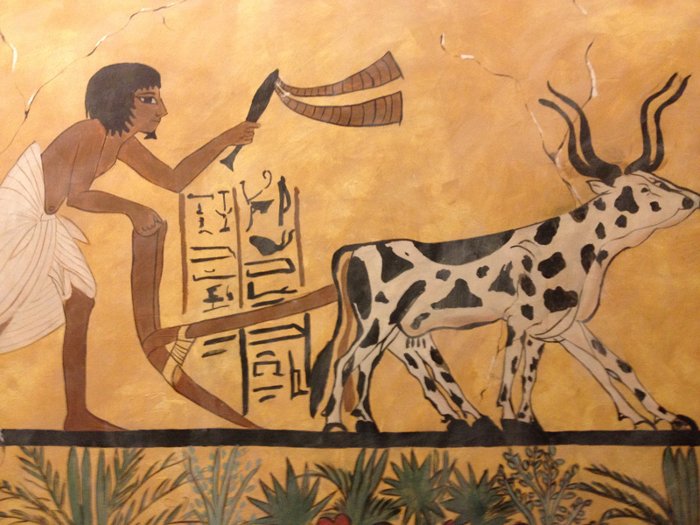People damage the environment from 6,000 years ago
The landmark change of the Earth's ecosystem began 6,000 years ago when people increased hunting, agricultural land use, fire use, animal domestication and sedentarization. .
Change the rule of existence 300 million years
It is hard to imagine a force that can change the laws of nature that existed on Earth for over 300 million years. However, a study in the United States called "Evaluating Flora and Fauna Changes in the past 307 million years" revealed a fact: The environment on Earth has been changed by humans since 6,000. last year
To reach the above conclusion, Dr. Kathleen Lyons and her colleagues at the American National Museum of Natural History had to study more than 359,000 fossils and modern animals in North America, Europe and Africa. They realized that although most species are randomly distributed in areas on Earth, there is still a group of species with special relationships. This relationship is expressed in: In an environment where this species occurs, the other species is also certainly present.
For example, elephants and giraffes often live in the same area because they share a habitat, or lions and zebras have a close relationship between predators and prey (if not one, then the other does not can exist).
Through research and statistics, the scientists discovered that in more than 300 million years, the number of pairs of animals with special relationships as above coexist in a much larger environment than today . Specifically, from the Coal Age (about 359.2 ± 2.5 million years ago) to the early Holocene (11,700 years ago), an average of 64% of animals have a special relationship with each other.

Ancient Egyptians cultivated agriculture thousands of years ago.(Photo: Morrowlife).
However, 6,000 years ago, when people began to increase activities such as hunting, agricultural land use, fire use, animal domestication and sedentarization, there was a big change. . According to scientists, only 37% of these species have a special relationship with each other.
They conclude that animals become more isolated from each other, meaning that where a species is found it is less likely to find the other species. The study also shows that there are many pairs of animals that are in a special relationship with each other for 300 million years. Those relationships have completely disappeared, the species have lived completely separate for about 6,000 years, when humanity increased its activities.
"Our research shows that people have a great influence on the environment for a long time and began reshaping the ecosystem on Earth about 6,000 years ago. We live in many areas with When these species no longer appear in those areas, they cannot survive in places where humans live, which means that animals are easily extinct. more strains, because there are fewer relationships between them, and because their geographic scope is smaller, their diversity is almost certainly less, " concluded Dr Lyons.
How do people change ecosystems?
There are 5 important changes in human activity that are considered by the researchers to be the main cause of ecosystem changes. The first is an increase in hunting during the Neolithic period , when people use stone tools to catch larger prey. Next is the change in agricultural land use , starting from the Middle East and spreading to other parts of the world such as Europe and North America .
Animal domestication also plays an important role in changing the ecological environment. The increased use of fire, fire to burn forests , increase of agricultural land or use it as an important weapon in hunting activities . also have a great impact on the environment.
Finally, the practice of sedentary farming and settlement has created barriers, narrowing the habitat of animals. People - both unintentional and deliberate - have pushed animals into new environments.
Dr Cindy Looy, a biologist at the University of California Berkeley, said: "The decline of species of the same species in the Holocene world is likely caused by population expansion. number of people and the result of land use, agricultural cultivation ".
Meanwhile, commented in the journal Nature, Dr. Gregory Deitl, a leading expert at the Institute of Paleontology Research in Ithaca, New York, said the study highlighted the danger. of using past information as a measure to predict what might happen in the future.
"I appreciate this research. It shows if the past and present are different, the use of the past to predict changes in ecosystems and then impose countermeasures is inaccurate. We cannot use the past as a guide to the uncertain future, " said Gregory Deitl.
- Son La earthquake does not cause damage
- Reducing vulnerability to marine resources and environment
- The image of the terrible environmental destruction in the world
- 10 most harmful creatures
- Severe environmental pollution in flooded areas
- US: Heavy damage due to floods and tornadoes
- The earth is silently saving the environment
- More than 220,000 people died from natural disasters in 2008
- New direction in treating heart damage
- The Mekong Delta excitedly welcomed the storm
- Healing heart damage in newborns through mitochondrial implants
- Blind people can see in 10 years
 Is the magnetic North Pole shift dangerous to humanity?
Is the magnetic North Pole shift dangerous to humanity? Washington legalizes the recycling of human bodies into fertilizer
Washington legalizes the recycling of human bodies into fertilizer Lightning stone - the mysterious guest
Lightning stone - the mysterious guest Stunned by the mysterious sunset, strange appearance
Stunned by the mysterious sunset, strange appearance